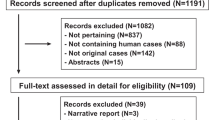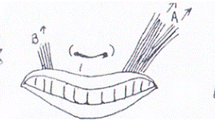Abstract
Background: Ehlers-Danlos syndrome (EDS) is a heterogenous group of diseases that can be potentially life threatening in the vascular form. The diagnosis is mainly based on a clinical score including many items that demonstrate skin, mucosa, joint, and vessel involvement. The score is particularly helpful in hypermobile and classical forms but can be normal in the vascular type. The absence of the lingual and inferior labial frenula was reported to be a useful diagnostic tool in a series of 12 patients with classical and hypermobile EDS. However, two further reports have contested the value of this sign.
Objective: To determine the diagnostic value of the absence of inferior labial or lingual frenula in EDS.
Methods: Patients with EDS were prospectively recruited from November 2006 to April 2007 in a French tertiary center. Each patient was examined to check for the presence or absence of the oral frenula and matched with two controls seen from February to May 2007.
Results: Forty-three patients (ratio female/male of 2.07 : 1, mean age 31 years, range 4–63 years), 4 with classical EDS, 19 with hypermobile EDS, and 20 with vascular-type EDS, were included and matched with 86 controls. The sensitivity of the absence of the inferior labial frenulum was 42% (95% CI 27, 58) and for the lingual frenulum was 53.5% (95% CI 38, 69). The specificity was 99% (95% CI 94, 100) and 98% (95% CI 92, 100), respectively. In the vascular group, 13 of 20 patients were affected (sensitivity = 65% [95% CI 41, 85]; specificity = 97% [95% CI 87, 100]; odds ratio = 72 [95% CI 8, 645]). Inter-observer agreement was excellent (κ value 0.91).
Conclusion: The absence of the inferior labial frenulum or lingual frenulum is a specific sign of EDS that can be easily checked by a physician. It can be helpful in the early diagnosis of the disease, including the vascular type, in affected families. It can also be helpful to distinguish between joint hypermobility syndrome and the hypermobile type of EDS in patients with joint hypermobility.





Similar content being viewed by others
References
Beighton P, De Paepe A, Steinmann B, et al. Ehlers-Danlos syndromes: revised nosology, Villefranche, 1997. Am J Med Genet 1998; 77: 31–7
Malfait F, De Paepe A. Molecular genetics in classic Ehlers-Danlos syndrome. Am J Med Genet C Semin Med Genet 2005; 139: 17–23
Germain DP, Herrera-Guzman Y. Vascular Ehlers-Danlos syndrome. Ann Genet 2004; 47: 1–9
Hamano K, Kuga T, Takahashi M, et al. The lack of type III collagen in a patient with aneurysms and an aortic dissection. J Vasc Surg 1998; 28: 1104–6
Lee ST, Kim JA, Jang SY, et al. A novel COL3A1 gene mutation in a patient with aortic dissected aneurysm and cervical artery dissections. Heart Vessels 2008; 23: 144–8
Kontusaari S, Tromp G, Kuivaniemi H, et al. A mutation in the gene for type III procollagen (COL3A1) in a family with aortic aneurysms. J Clin Invest 1990; 86: 1465–73
Germain DP. Ehlers-Danlos syndrome type IV. Orphanet J Rare Dis 2007; 2: 32
North KN, Whiteman DA, Pepin MG, et al. Cerebrovascular complications in Ehlers-Danlos syndrome type IV. Ann Neurol 1995; 38: 960–4
Lim SP, Duddy MJ. Endovascular treatment of a carotid dissecting pseudoaneurysm in a patient with Ehlers-Danlos syndrome type IV with fatal outcome. Cardiovasc Intervent Radiol 2008; 31: 201–4
Abel MD, Carrasco LR. Ehlers-Danlos syndrome: classifications, oral manifestations, and dental considerations. Oral Surg Oral Med Oral Pathol Oral Radiol Endod 2006; 102: 582–90
de Felice C, Toti P, Di Maggio G, et al. Absence of the inferior labial and lingual frenula in Ehlers-Danlos syndrome. Lancet 2001; 357: 1500–2
Perrinaud A, Matos M, Maruani A, et al. Absence of inferior labial or lingual frenula in Ehlers-Danlos syndrome: a new diagnostic criterion? [in French]. Ann Dermatol Venereol 2007; 134: 859–62
Böhm S, Martinez-Schramm A, Gille J, et al. Missing inferior labial and lingual frenula in Ehlers-Danlos syndrome [letter]. Lancet 2001; 358: 1647
Shankar S, Shirley E, Burrows NP. Absence of inferior labial or lingual frenula is not a useful clinical marker for Ehlers-Danlos syndrome in the UK. J Eur Acad Dermatol Venereol 2006; 20: 1383–4
Mintz SM, Siegel MA, Seider PJ. An overview of oral frena and their association with multiple syndromic and non-syndromic conditions. Oral Surg Oral Med Oral Pathol Oral Radiol Endod 2005; 99: 321–4
Kantaputra PN, Pruksachatkunakorn C, Vanittanakom P. Rapp-Hodgkin syndrome with palmoplantar keratoderma, glossy tongue, congenital absence of lingual frenulum and of sublingual caruncles: newly recognized findings. Am J Med Genet 1998; 79: 343–6
Grahame R, Bird HA, Child A. The revised (Brighton 1998) criteria for the diagnosis of benign joint hypermobility syndrome (BJHS). J Rheumatol 2000; 27: 1777–9
Fleiss J. Measuring nominal scale agreement among many raters. Psychol Bull 1971; 76: 378–82
Landis JR, Koch GG. The measurement of observer agreement for categorical data. Biometrics 1977; 33: 159–74
Susuki S. Conditional relative odds ratio and comparison of accuracy of diagnostic tests based on 2 × 2 tables. J Epidemiol 2006; 16: 145–53
Bravo JF, Wolff C. Clinical study of hereditary disorders of connective tissues in a Chilean population: joint hypermobility syndrome and vascular Ehlers-Danlos syndrome. Arthritis Rheum 2006; 54: 515–23
van der Giessen LJ, Liekens D, Rutgers KJ, et al. Validation of Beighton score and prevalence of connective tissue signs in 773 Dutch children. J Rheumatol 2001; 28: 2726–30
Gorlin RJ, Cohen Jr MM. Craniofacial manifestations of Ehlers-Danlos syndromes, cutis laxa syndromes, and cutis laxa-like syndromes. Birth Defects Orig Artic Ser 1989; 25: 39–71
Acknowledgments
No sources of funding were used to assist in the preparation of this study. The authors have no conflicts of interest that are directly relevant to the content of this study.
Author information
Authors and Affiliations
Corresponding author
Rights and permissions
About this article
Cite this article
Machet, L., Hüttenberger, B., Georgesco, G. et al. Absence of Inferior Labial and Lingual Frenula in Ehlers-Danlos Syndrome. Am J Clin Dermatol 11, 269–273 (2010). https://doi.org/10.2165/11530090-000000000-00000
Published:
Issue Date:
DOI: https://doi.org/10.2165/11530090-000000000-00000




